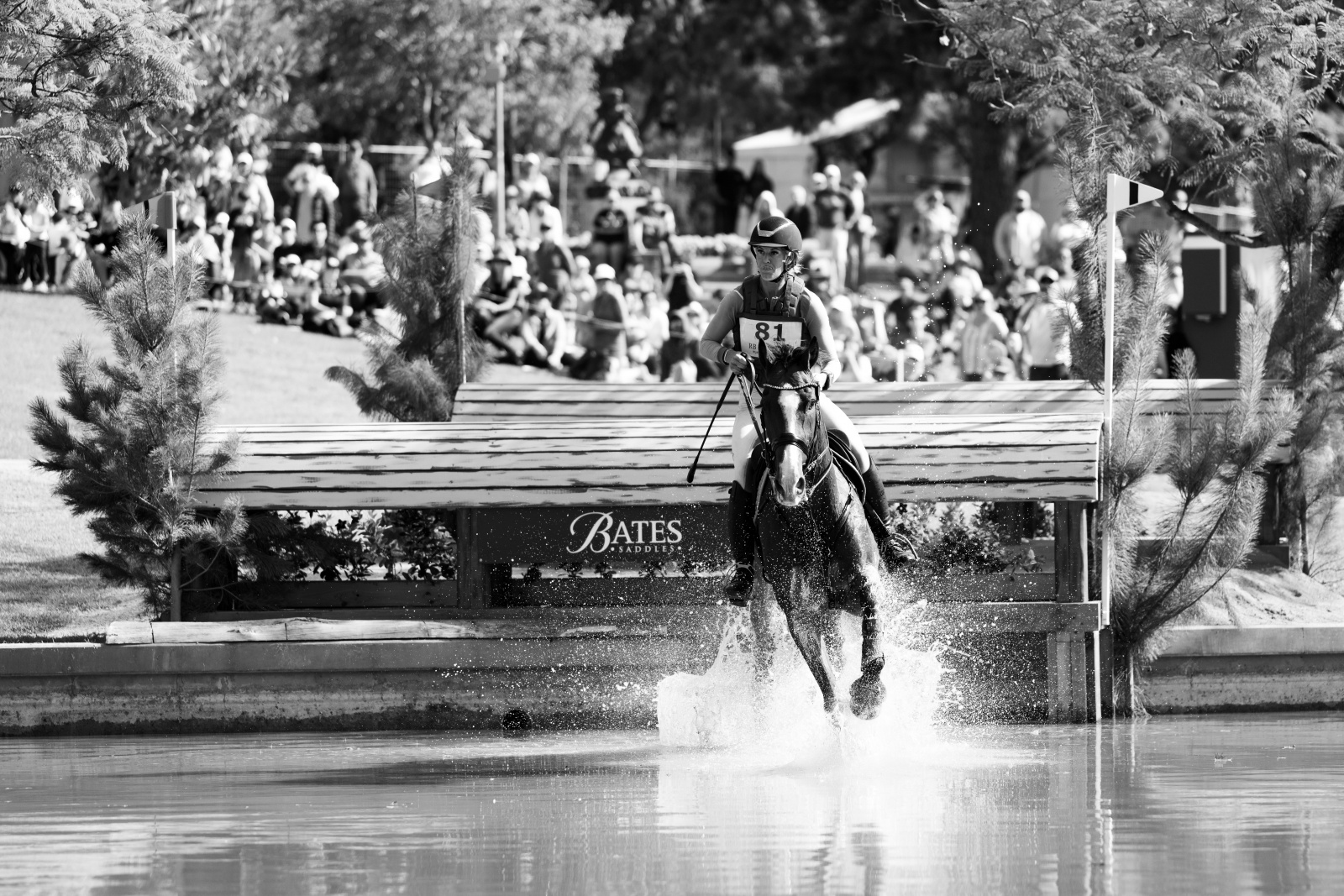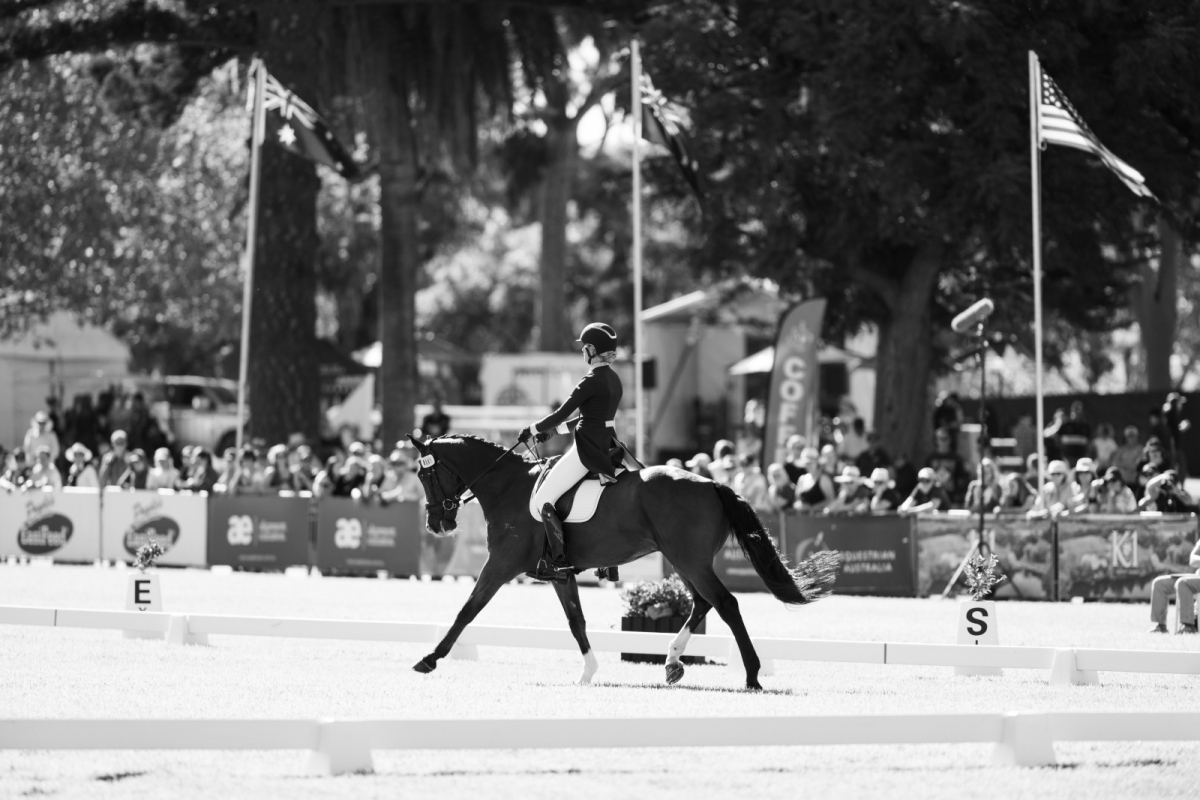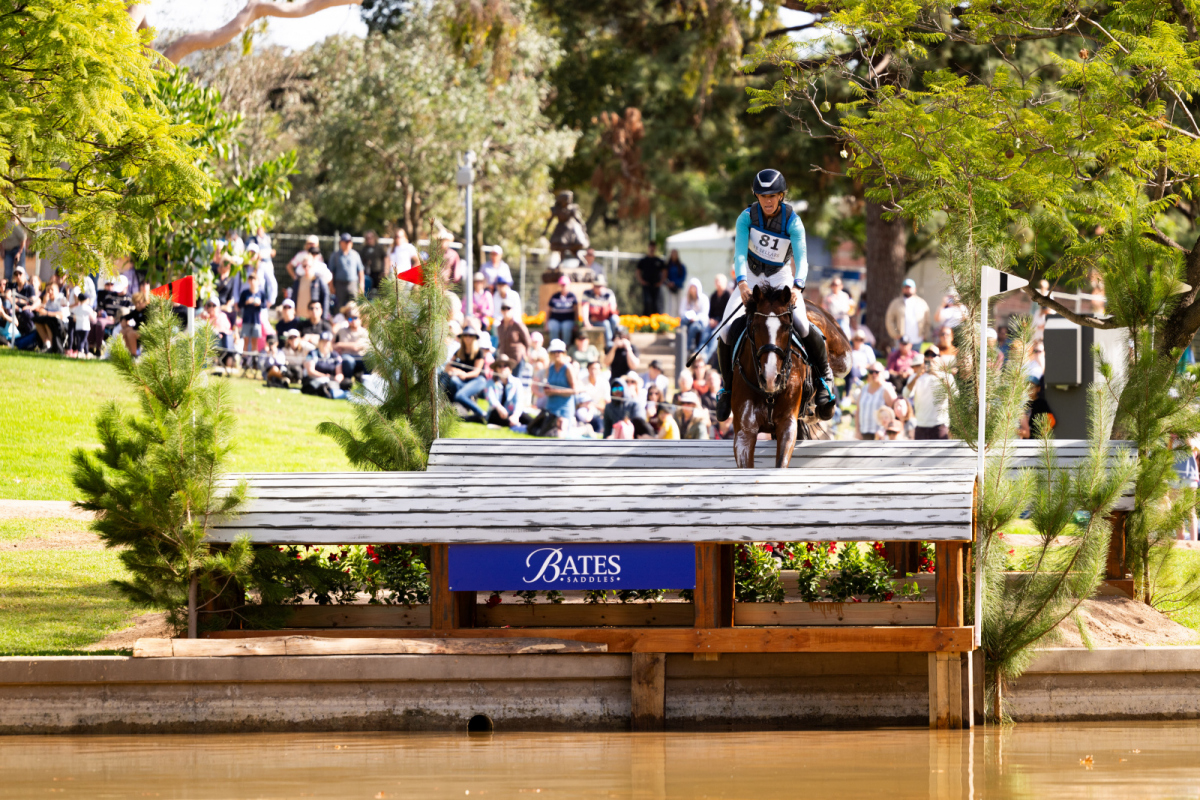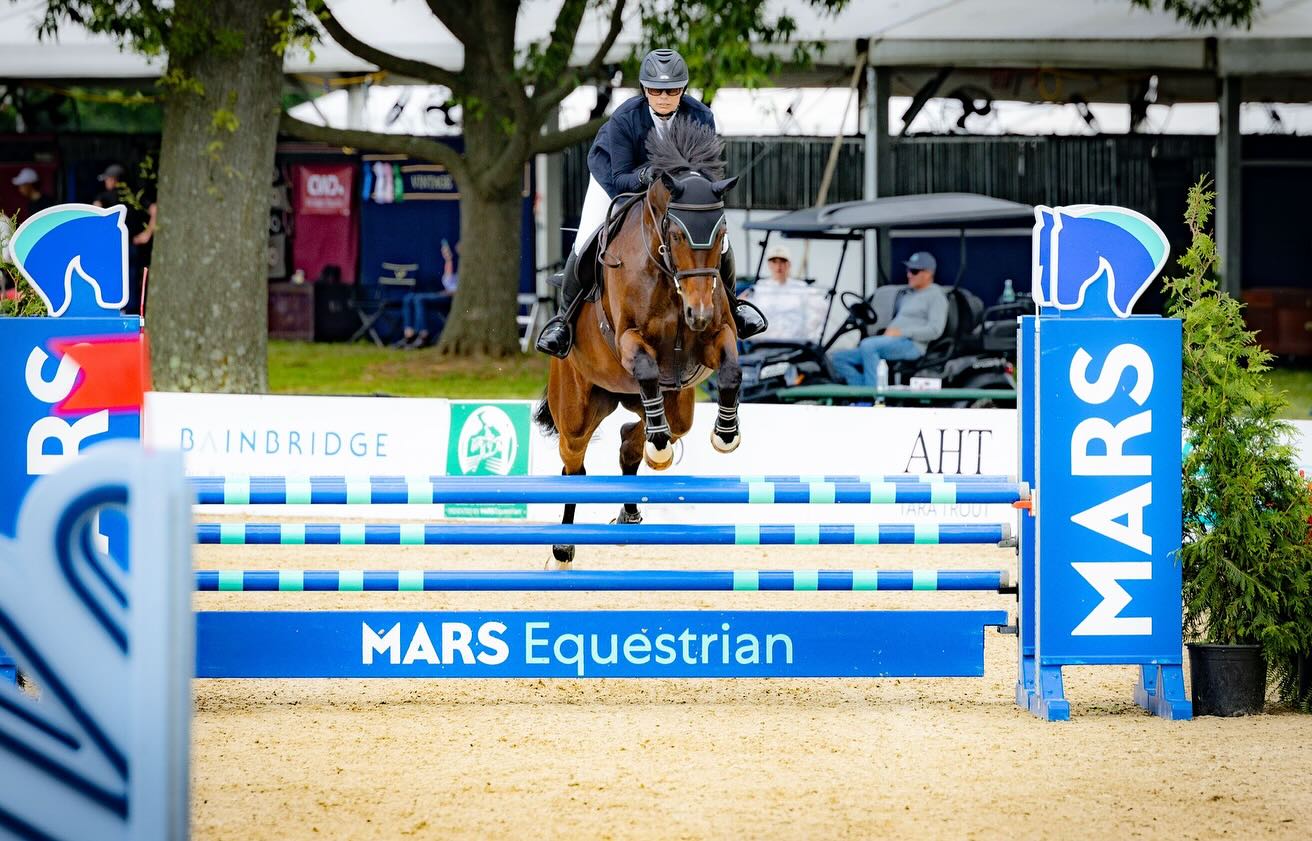EN roving reporter and photographer Atalya Boytner made a special trip to the southern hemisphere to experience eventing in Australia. The Adelaide Equestrian Festival hosts an annual CCI5* alongside other international competitions, and it’s a spectacle we’ve always wanted to see for ourselves. Through Atalya’s eyes, let’s dive in to an incredible weekend of horse sport “down under.”
The Setting
First impressions of Adelaide:
Walkable. Accessible. Beautiful.
I don’t know what I expected from a competition that makes its calling card about their location in the middle of a city but in my experience with equestrian events, “middle of a city” is a generous term.
Not so here.
The Adelaide Park Lands, a National Heritage site, cover about 932 hectacres (that’s a whooping 2303 acres) and provides dog parks, exercise structures, barbeque areas, running trails, cycling trails, horse racing, and what I think looks like a car race track to the populace of the City of Adelaide. While the cross country course winds its way through much of the Park Lands, the main arena and all the associated infrastructure takes place in Victoria Park, also known as Pakapakanthi in language of the Kuarna people.
It’s about a 30-minute walk from downtown Adelaide, also known as the CBD – Central Business District but it’s more fun if you don’t know that. Or 10 minutes from the east end of Adelaide. Myself and my roller bag of chock-full camera gear along with a backpack of necessary snacks, extra batteries, and water conquered the walk twice a day passing Bauhus-like fire stations, glass box office buildings, art deco shops and galleries, and many, many stone churches. A city of festivals and food, there’s a Tasting Australia event that I walk through every day to get to the Adelaide Equestrian Festival. I pass Greek restaurants, every kind of Asian restaurant you could dream up, Italian, French, and delicious coffee on almost every corner. A footy game (based on excited Australian explanations to the ignorant American, it sounds like a mix between soccer, football, and rugby with a dash of cricket) came to town Saturday night which started plenty of time after the eventing finished for a leisurely stroll over to the stadium, 20 min from Victoria Park.
All this to say, heart of the city is not just a saying. It’s fact.
You would be forgiven for thinking this means being physically fit and able. You would be incorrect.
In one week of being in Adelaide, I have seen more wheelchair bound individuals then I have seen in an entire month in the US. They are often solo, living life as independent and able members of society, going grocery shopping in the market I have been frequenting for my morning caffeine fix or simply enjoying a nice time with friends. Businesses have clear accessible routes marked, the public streets are designed without steps everywhere, and no one bats an eye, just simply make room on the sidewalk. Even on cross country day at the equestrian festival, I had to weave and work around many different people with wheelchairs. It is an event truly open to all who wish to come.

One of two road crossings that make Adelaide truly unique in its placement within the heart of the city. Photo by Atalya Boytner.
For a Californian, the landscape of Adelaide feels like home. Rolling sandy hills, eucalyptus trees everywhere, and a lovely soft sun to light everything. But there is history here too.
The Heritage Grand Stand is equal in grandeur and presence to the iconic palaces and country homes we see in the UK and is as integral to a vision of Adelaide as the Rolex Stadium in Kentucky. Built in the 1880s, its cast iron lacework filigree and blue stone base makes for a beautiful backdrop to the jogs, dressage, and show jumping phases. The English and German influence in the Adelaide city architecture makes its mark in the equestrian events too with its fun and playful style of marrying the old history with new design.
That playful style made its way onto the cross country at Adelaide, whose design from the outside may not seem as intimidating as the other 5* events across the globe. The fences themselves are all portable though they do not look it. Big tables, huge open corners that caused grief all over the course, lots of brush, and one fence that stands out from all the rest.

Muralist, activist, and artist-in-residence Matt Wiley puts the finishing touches on one of the artful masterpieces on the cross country course. Photo by Atalya Boytner.
Fence 24, the Beehives, was a straightforward galloping table for the horses and riders to navigate but its decoration sparked interest. Decorated with four pillars, two on each side that would later become show jumping standards, they were inspired by Adelaide architecture with mock stone edging and trim along their roof line. Each side of the pillar was hand painted by muralist, activist, and artist-in-residence Matt Wiley as part of his “The Good of the Hive” project.
“I really look for projects that bring two things that you wouldn’t think of together because my work is about creating curiosity around the bees,” he explained. “When somebody says, why bees at as a jump? Immediately they’re in the state of mind that I want. Because when people are questioning, that’s when they’re open to learning something. I’ve been hearing [here at Adelaide Equestrian Festival] about the way that people work with their horses. You’re listening to your horse. How you nurture that relationship with the horse really got me thinking about, how do we nurture our relationships with pollinators? How are we thinking about taking care of them and listening to what they need?”
The structure of the jump was all Mike Etherington-Smith, the course designer at Adelaide, and his team of builders but Matt made sure to speak with them about the design he would paint on the face.
“I’d never done a jump, I had a lot of questions about it! Are the bees that I paint going to freak out the horses? I wanted to use black, because of the contrast with the grass and the colors. But I [didn’t] know what that does for depth when a horse is going up. So I had a lot to learn and the design of it, but I really leaned on [the course designer and builders] to advise me.”
But you didn’t come here to hear me wax poetic. What about the eventing?
The Stories
The make-up of the 2025 Adelaide CCI5* field is one that makes us remember why eventing is so special.
Every rider (based on FEI records) has brought their own horse up the levels themselves. All of them have been partnered with their rides for 3 or more years with most of them together as combinations since 2017. The horses are Thoroughbreds and homebreds, with a dash of warmblood here and there. There are amateurs competing alongside professionals and Olympians. Young blood and veterans are having a go of the highest level of sport.
It’s human.
While the Kentucky’s, Badminton’s, Luhmühlen’s, and all the elite levels of sport with their pomp and splendor are undeniably exciting, here I find myself reconnecting to that old excitement: this sport is for everyone and while it’s never easy and often requires every part of yourself, the doors to glory are open if only you have the grit and gumption to get to them.
It was a competition for the homebreds, the Thoroughbreds, and the rookies.
David Middleton brought not one but two homebreds in WEC In the Money and WEC In the Breeze to contest the competition. Sophia Hill and her off-track Thoroughbred Humble Glory have traveled overseas and invested in their education to come back home better than ever. Amateur Joel Funnell came solo with his mount Airbrushed and did everything himself. Shane Rose, stalwart Australian team member and three-time Olympian, brought two off-track Thoroughbreds he acquired from a truckload to contest their first 5* after breaking his pelvis and femur in a fall early in 2024.
Ninth place finisher Yona Lloyd fulfilled a dream at his third attempt at the level and his horse’s first. A clear cross country round the day before with time added and two rails down on a day when they were flying meant he secured a top 10 on an unassuming little bay with a heart of gold. Bred by a friend and owned by Lloyd and close friends, Ballahowe Ayurvedic or ‘Wiz’ has been with Yona almost his entire life.
“You look at him, and he doesn’t look like a high-level horse. But when he’s out and going, he’s just got amazing scope and feels like he could jump whatever I stick him at,” Yona said. “We came here with the aim of finishing and having a really positive weekend for him, just for him to grow. I felt like that’s what happened. He’s been here the last two years in the CCI4*-S and CCI3*-L. Each year, [he’s] just progressing along and getting more comfortable. We struggle to get this environment in Australia. Yeah no, so stoked! He’s such a giving horse. I couldn’t ask for more.
Fourth place went to 5* rookie Jess Somerfield who brought a Queensland-bred horse in Finch Farm Carpentaria to contest her and the horse’s first 5* in a story that feels like a fairy tale.
“He’s nothing short of quirky,” Jess describes ‘Finchy’, who was put on her radar by a former coach willing to sell her the horse for $1. “He’s so careful [and horse shy]. We had so many ditch problems and water jumps starting up. Then all of a sudden, this horse has just been everything and risen through the levels. I had a goal of going five-star this year, and I had an accident off my other horse and broke my collar bone.” Jess went on to the CCI4*-L at Werribee in June, but aggravated a fracture in her shoulder that had gone unnoticed before, making her arrival here at Adelaide all the more special. “You dream your whole life to do this. There’s no other horse that I would want to be on that last two minutes of cross country. I know that I’ve got his heart, and he’s got mine, and he’ll look after me. I just have every inch of trust in him through this journey.”
As the incredible speaker and leadership thinker Simon Sinek says: “We have to dream. How else will we make a future that does not yet exist?”
For Jess and the team behind Finchy, that rings true. All their blood, sweat, and tears culminated in her best birthday present ever: a clear 5* cross country course with only time added to move her into the top five.
The Competition
That final day of competition felt a bit surreal for me too.
Walking into the park, listening to the bird calls in the wind in the trees – actually a very different sound than the wind in the trees in U.S., the old song came to mind: kookaburra sits in the old gumtree, merry merry king of the bush is he. The corellas loudly proclaim their territory, little noisy miners flit here and there, and indeed a couple kookaburras stare me down as I go by. It feels weirdly full circle though I’ve never had anything to do with Australia before in my life.
The whole media centre says hello to me as I walk in. Each person has been enormously helpful. My experience with 5* events in North America, whether eventing or show jumping, has always been about rules and all the things we as media representatives cannot do. Adelaide is much gentler and the freedom left me turning to those more knowledgeable about appropriate decisions (having permission to cross galloping lanes during cross country gave me a secret thrill every time. If you’ve ever worked the Kentucky or Maryland events and stressed about crossing points, you’ll know how much of a help this was). No matter how silly my questions must’ve seemed, the grace and kindness extended towards me was truly humbling. From remote camera placements to getting quotes from riders to jokingly bemoaning the fact that course designers never think of photographers, no level of support proved too big or too small.
Just like the dressage and cross country, show jumping had its due influence on the competition. No one went double clear though heartbreakingly close was Sophia Hill who unfortunately went off course three fences from the finish and thus were eliminated.
When the leader after cross country, Shane Rose and The Bandit, had three rails down, it was Hazel Shannon and the off-track Thoroughbred WillingaPark Clifford for the win. They set a new record as the only combination to win the Adelaide CCI5* four times. This puts their names alongside the likes of Oliver Townend (GBR) and Ballaghmor Class and Michael Jung (GER) and La Biosthetique Sam in the history books as one of the few combinations to win a 5* three times or more together.
At 19 years old (20 in Thoroughbred years), there’s no doubt there were questions about ‘Clifford’ running a competition of this intensity. The distance, effort, and stamina need no explanation on how challenging and difficult they prove to be for horses of every age and experience. It wasn’t initially in Hazel’s plans to aim for a 5*, but after a good winter season and a strong, fit horse, she put in her entry and made the trek from Hunter Valley near Sydney to Adelaide.
Clifford showed everyone, including Hazel, that he is not interested in slowing down and you can keep your doubts to yourself, thank you very much. He scored a 30.2 in the dressage, added 11.6 time penalties on cross country, and one rail down in the show jumping to prove himself the best of the lot and take home to the win.
“I mean, 19 surely. How much longer can they go for?” Hazel laughed. “But I’ve been saying that for years. Clifford is just a mountain; he’s a bit of a freak and an outright, five-star horse. I do everything I can [for him]. I am really watchful about how much work I do and what surfaces I ride on. But he’s just an incredible horse. Some of them are born really tough, and he is definitely one of the toughest out there. I had probably a 1/10th of a say out on cross country but I’m really happy with how he’s gone.”
When asked if he was coming back next year, Hazel jokingly said, “I’ve been saying no for the last three years so surely not but it’s up to Clifford.”
Truly he was not one bit out of step. Ears pricked, coat shiny, and not a hair out of place after the show jumping, he looked ready to tackle another cross country course.
Adelaide stole my heart and if you’re not careful, it will steal yours too. The glory of this event isn’t in the fancy horses or the pageantry or even the venue itself but in the long, slow, gritty, and determined work of dreams being quietly realized.
Now if you’ll excuse me, I’ve been promised wild koalas and kangaroos so don’t mind if I see myself out!
Adelaide Equestrian Festival CCI5*: [Website] [Live Stream Replays] [Scores]
- Photo by Atalya Boytner.
- Photo by Atalya Boytner.
- Photo by Atalya Boytner.
- Photo by Atalya Boytner.
- Photo by Atalya Boytner.
- Photo by Atalya Boytner.
- Photo by Atalya Boytner.
- Photo by Atalya Boytner.
- Photo by Atalya Boytner.
- Photo by Atalya Boytner.
- Photo by Atalya Boytner.
- Andrew Cooper and Sharvalley Thunder. Photo by Atalya Boytner.
- Photo by Atalya Boytner.
- Photo by Atalya Boytner.
- Photo by Atalya Boytner.
- Photo by Atalya Boytner.
- Photo by Atalya Boytner.
- Photo by Atalya Boytner.
- Photo by Atalya Boytner.
- Photo by Atalya Boytner.
- Photo by Atalya Boytner.

















































































